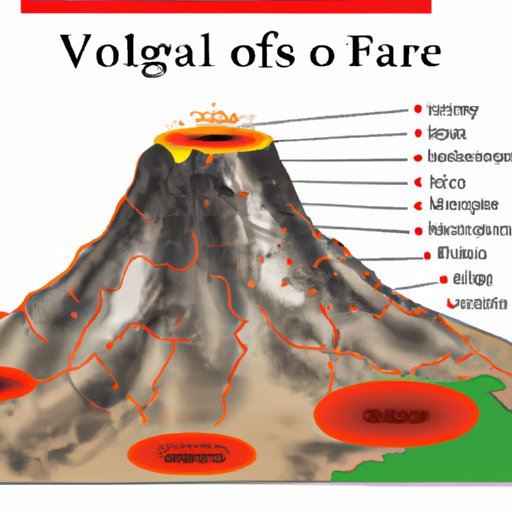Introduction
Volcanoes are natural landforms that form when molten rock, or magma, erupts from a vent in the Earth’s surface. They come in all shapes and sizes, ranging from small cinder cones to massive composite volcanoes. While they can occur anywhere on the planet, there are certain areas that are more prone to volcanic activity than others. This article will explore these areas, delving into the geography of volcanic activity and examining the major volcanic zones around the globe.
Exploring the Geography of Volcanic Activity: Where Do Most Volcanoes Occur?
When it comes to understanding where most volcanoes occur, it is important to remember that they are not randomly distributed around the planet. Instead, they tend to be concentrated in certain regions, which are known as hotspots. These hotspots are areas where magma is able to reach the surface relatively easily, resulting in frequent eruptions. Let’s take a closer look at the major volcanic zones around the world.
Mapping the Hot Spots: A Guide to the World’s Most Volcanic Regions
The majority of the world’s active volcanoes are located along the edges of the Pacific Ocean, an area commonly referred to as the “Ring of Fire”. This belt of volcanoes stretches from the Aleutian Islands in the north to New Zealand in the south, encompassing many of the islands of the South Pacific. The Ring of Fire is home to some of the world’s most active volcanoes, including Mount St. Helens, Mount Fuji, and Kilauea.
In addition to the Ring of Fire, there are other areas of the world that are prone to volcanic activity. These include the Mediterranean region, the Andes Mountains, and Iceland. The Mediterranean region is home to several active volcanoes, including Mount Etna and Mount Vesuvius. The Andes Mountains are home to numerous volcanoes, such as Cotopaxi and Chimborazo. Finally, Iceland is home to some of the world’s most active volcanoes, including Eyjafjallajökull and Hekla.
Volcano Hotspots: What Causes Areas to Be More Prone to Volcanic Eruptions?
So what causes some areas to be more prone to volcanic activity than others? To answer this question, we need to understand the factors that contribute to increased volcanic activity. Generally speaking, these factors can be divided into two categories: geological and geographical.
Geological factors include the presence of magma chambers beneath the Earth’s surface, as well as the type of crust that the volcano is located on. Magma chambers are underground reservoirs of molten rock that can become pressurized over time, leading to explosive eruptions. The type of crust that the volcano is located on can also affect its activity. For example, oceanic crust is much thinner and denser than continental crust, allowing magma to reach the surface more easily.
Geographical factors include the location of the volcano relative to plate boundaries. Plate boundaries are areas where two plates meet and interact, resulting in seismic activity and, in some cases, volcanic eruptions. Examples of plate boundaries include subduction zones (where one plate slides beneath another) and rift zones (where two plates are splitting apart). Volcanoes located near these boundaries are more likely to experience increased activity due to the interaction of the plates.
Examples of volcanic hotspots include the Pacific Northwest of the United States, the Kamchatka Peninsula in Russia, and the islands of Indonesia. All of these areas are located near major plate boundaries, resulting in increased seismic activity and frequent eruptions.
A Geographic Analysis: Investigating the Relationship Between Plate Tectonics and Volcanism
To further understand the relationship between plate tectonics and volcanism, we need to consider how plate tectonics affects volcanism. Plate tectonics is the study of how large plates of the Earth’s lithosphere move and interact with each other. When two plates collide, they can cause earthquakes, which can in turn trigger explosive volcanic eruptions. Similarly, when two plates pull apart, the resulting tension can create fissures in the ground, allowing molten rock to reach the surface.
It is also important to note that the direction of plate movement can affect the type of volcanism that occurs. For example, subduction zones tend to produce explosive eruptions, while rift zones tend to produce effusive eruptions. In addition, the composition of the magma plays a role in determining the type of eruption that takes place.
Conclusion
In conclusion, this article has explored where most volcanoes occur around the world. We have looked at the major volcanic zones and identified the factors that contribute to increased volcanic activity. We have also investigated the relationship between plate tectonics and volcanism, and discussed how the direction of plate movement can affect the type of eruption that takes place. By understanding the geography of volcanic activity, we can better prepare for future eruptions and mitigate their effects.


